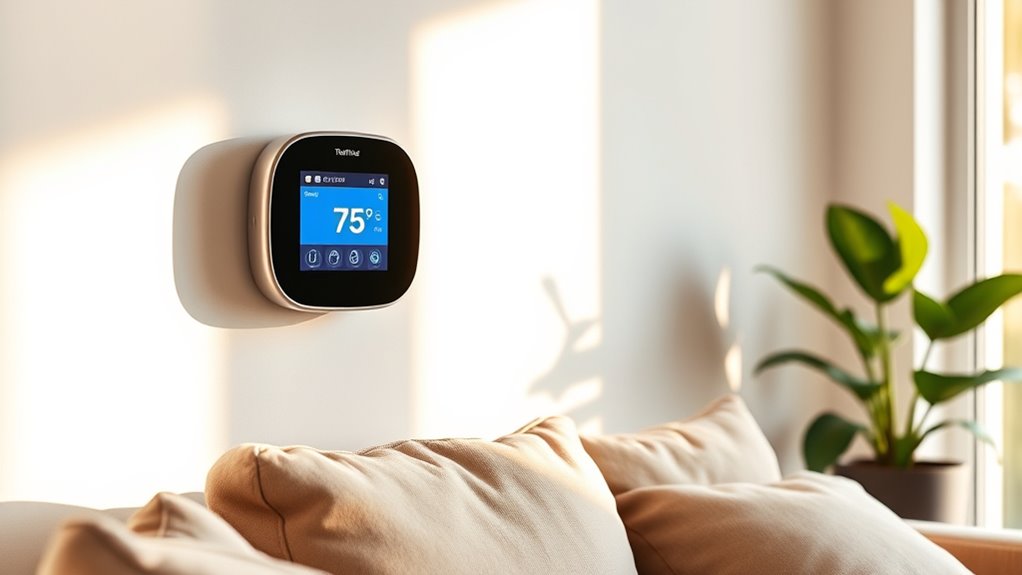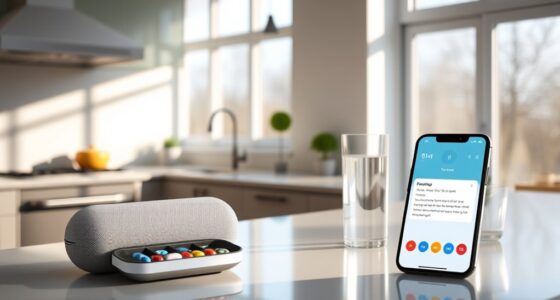Set your smart thermostat to comfortable temperatures seasonally—around 68°F in winter and 78°F in summer—and adjust when you’re away or sleeping. Use schedules and geofencing to automatically save energy and stay comfortable. Fine-tune humidity levels to 40-50% for ideal comfort, and customize settings for different routines and occupants. Keep monitoring and adjusting for efficiency, and you’ll discover more ways to maximize savings without sacrificing comfort.
Key Takeaways
- Set seasonal temperature targets (68°F in winter, 78°F in summer) to balance comfort and energy efficiency.
- Use geofencing to automatically adjust settings based on home occupancy and arrival times.
- Create personalized profiles for different routines and occupant preferences to optimize comfort and reduce waste.
- Schedule temperature changes during absences and sleep periods to maximize savings without sacrificing comfort.
- Regularly monitor energy use and fine-tune thermostat settings to adapt to seasonal shifts and occupancy patterns.
Optimal Temperature Settings for Different Seasons

Adjusting your smart thermostat to suit the seasons can help you save energy and stay comfortable year-round. During colder months, set your thermostat to around 68°F (20°C) when you’re home, and lower it when you’re away or asleep. In summer, aim for 78°F (26°C) when you’re active and higher when you’re gone. Proper temperature calibration guarantees your thermostat maintains these settings accurately, preventing energy waste. Don’t forget about humidity control—keeping indoor humidity levels between 30-50% improves comfort and efficiency. Maintaining optimal humidity levels reduces the workload on your cooling or heating system, making temperature calibration more effective. Adjusting these settings seasonally helps optimize comfort while reducing energy bills and preserving your HVAC system’s longevity.
Utilizing Smart Scheduling for Energy Efficiency
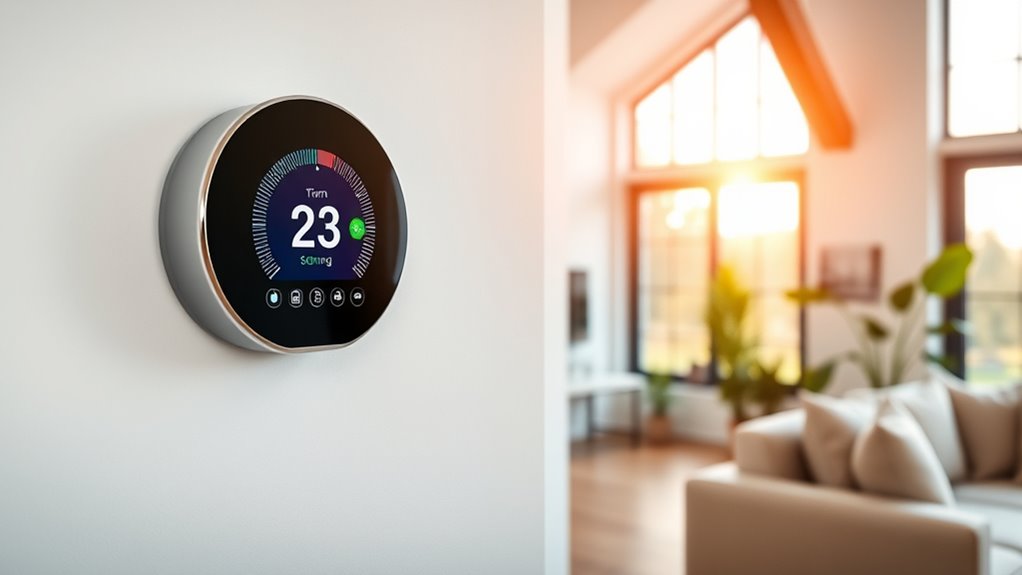
Implementing smart scheduling features on your thermostat allows you to automate temperature adjustments based on your daily routines, maximizing energy savings. With schedule optimization, you can set your thermostat to lower heating or cooling during times you’re away or asleep, reducing unnecessary energy consumption. By creating tailored schedules, you prevent the system from running at full power when it’s not needed, leading to significant savings on your energy bills. Many smart thermostats learn your habits over time, fine-tuning schedules to match your lifestyle automatically. Consistent schedule management guarantees your home stays comfortable when you’re home and conserves energy when you’re not. This proactive approach to temperature control helps you balance comfort with efficiency, making your home more eco-friendly and cost-effective. Energy-efficient scheduling also encourages mindful energy use, helping reduce your carbon footprint.
Leveraging Geofencing to Maximize Comfort and Savings
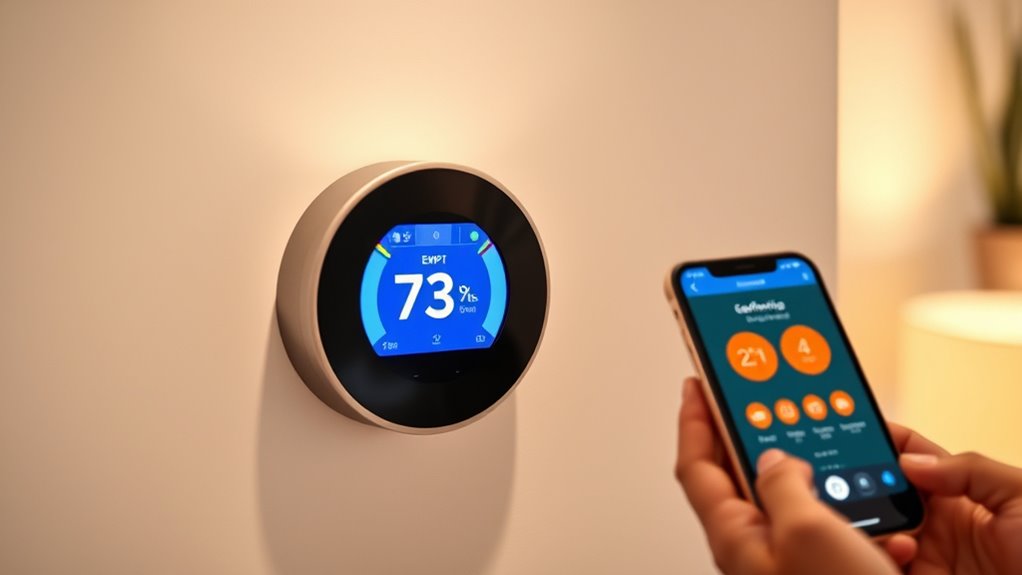
With geofencing, your thermostat can automatically detect when you’re home or away, ensuring your space stays comfortable and energy-efficient. It adjusts settings based on your location, so you don’t waste energy when you’re gone. This smart feature helps maximize savings without sacrificing comfort. Additionally, integrating lifestyle insights like private paradises can inspire personalized and luxurious home environments that enhance your overall comfort.
Automatic Location Detection
Have you ever wondered how your thermostat can automatically know when you’re home or away? Automatic location detection uses geofencing to track your smartphone’s position, adjusting your home’s temperature accordingly. When you arrive, the system detects your presence and switches to a comfortable setting; when you leave, it saves energy by lowering heating or cooling. This seamless process works behind the scenes, so you don’t have to manually set the thermostat each time. You can also control your system remotely through an app, giving you peace of mind and flexibility. For added convenience, voice commands enable you to adjust settings on the fly without needing to access your device physically. Automatic location detection makes maintaining comfort and saving energy effortless and intuitive.
Adjusting for Absence
When you leave your home, geofencing technology kicks in to automatically adjust your thermostat for maximum savings and comfort. It detects your absence and switches to vacation mode, reducing energy use while maintaining a comfortable environment for your return. If you need to override settings temporarily, a manual override allows flexibility without disrupting automation. Understanding how to balance absence adjustments ensures ideal savings and comfort. Here’s a quick guide:
| Situation | Action | Benefit |
|---|---|---|
| Leaving home | Enable geofencing | Saves energy during absence |
| Returning home | Auto switches to comfort | Ensures comfort upon arrival |
| Need immediate change | Manual override | Flexibility when needed |
| Extended absence | Activate vacation mode | Maximize savings |
| Resuming normal use | Deactivate vacation mode | Return to regular settings |
Using geofencing and manual controls effectively helps tailor your thermostat to fit your lifestyle. Understanding load‑planning is key to ensuring your system can handle your household’s energy needs efficiently.
Adjusting Humidity Levels for Enhanced Comfort
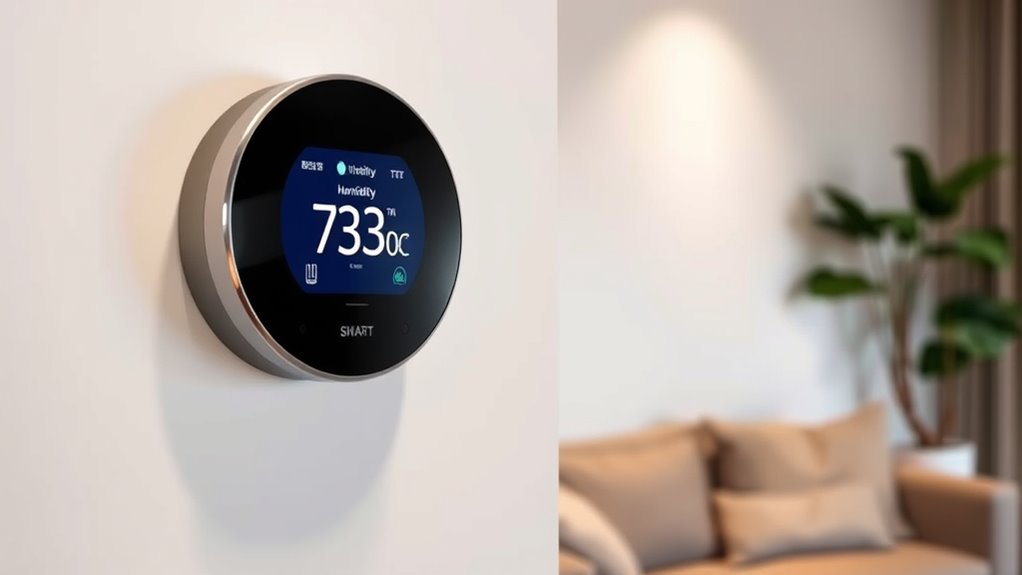
Adjusting humidity levels is a key step in maximizing your comfort with a smart thermostat. Proper humidity improves indoor air quality and prevents issues like dryness or excess moisture. If your home has a humidifier, integrating it with your smart thermostat allows precise control of moisture levels. Aim for humidity around 40-50%, which keeps your environment comfortable and reduces static electricity. Too low, and you may experience dry skin and irritations; too high, and mold or dust mites could thrive. Your thermostat’s sensor can help monitor humidity, so you can make real-time adjustments or set schedules. Regularly checking indoor air quality can also inform your humidity adjustments. By fine-tuning humidity, you create a more comfortable, healthier living space while also protecting your home’s structure and furnishings.
Customizing Settings for Home Occupants
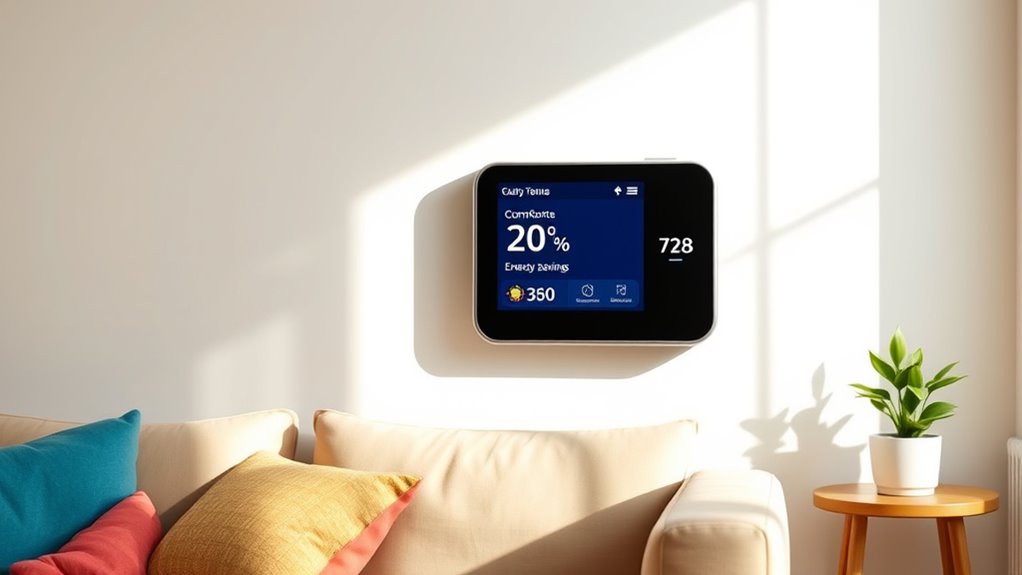
To guarantee your smart thermostat meets everyone’s comfort needs, customizing settings for different home occupants is essential. You can create personalized profiles that reflect each person’s preferences, ensuring ideal comfort and efficiency. For example, set warmer temperatures for mornings and cooler ones for evenings based on individual routines. Use occupant preferences to assign specific schedules and temperature ranges. Here’s a sample of personalized profiles:
| Occupant | Preferred Temp | Active Hours | Special Notes |
|---|---|---|---|
| Alice | 72°F | 6 AM – 9 AM, 5 PM – 10 PM | Sensitive to cold |
| Bob | 68°F | 7 AM – 8 AM, 6 PM – 11 PM | Works from home |
| Kids | 75°F | 7 AM – 9 AM, 3 PM – 9 PM | Sleep early, active afternoons |
| Elderly | 70°F | 8 AM – 10 PM | Prefer consistent warmth |
| Guest | 70°F | Flexible | Temporary profile |
Creating these profiles helps confirm everyone stays comfortable without wasting energy.
Tips for Fine-Tuning Your Smart Thermostat Over Time
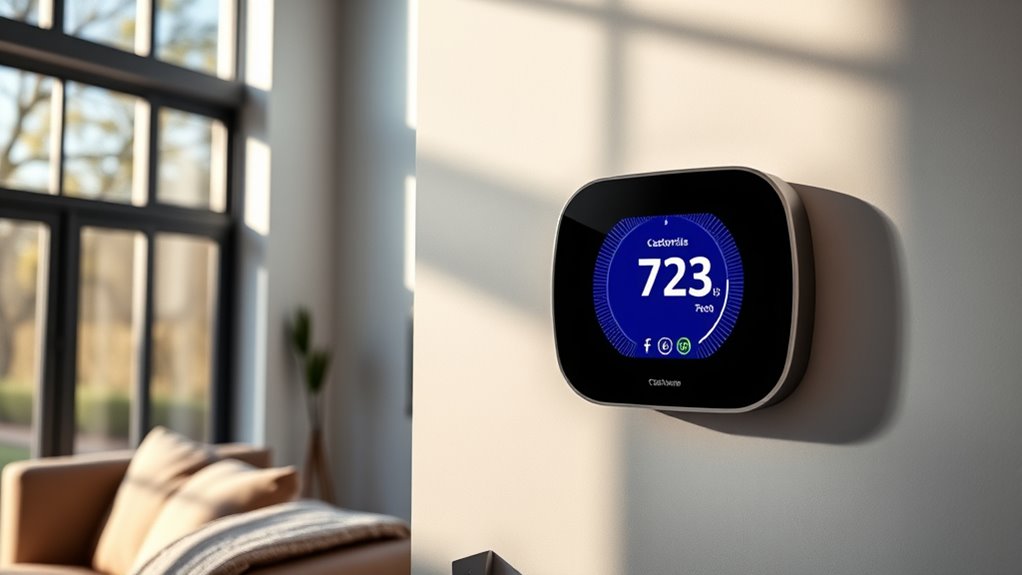
To keep your smart thermostat working efficiently, you should adjust its settings seasonally. Regularly monitoring your usage trends helps you spot patterns and identify opportunities to conserve energy. Making these small tweaks over time ensures your home stays comfortable and cost-effective. Additionally, conducting periodic home energy audits can help you understand where improvements are most needed and maximize your energy savings.
Adjust Seasonally
Have you ever noticed how your comfort needs change with the seasons? To stay cozy and save energy, modify your thermostat settings accordingly. Each season demands different temperatures, so perform seasonal maintenance like checking for drafts and cleaning filters. Also, consider recalibrating your thermostat to guarantee accurate readings. Visualize these adjustments with this simple table:
| Season | Ideal Temp Range | Tips for Adjustment |
|---|---|---|
| Winter | 68–72°F | Lower during sleep, seal drafts |
| Spring | 65–70°F | Set to cool, open windows |
| Summer | 75–78°F | Use fan mode, shade windows |
| Fall | 65–68°F | Prepare for colder weather |
| Transitional | 68–72°F | Fine-tune as needed |
Adjusting seasonally helps optimize your comfort and energy savings over time. For long-term efficiency, consider exploring sustainable heating and cooling practices, which can enhance your home’s overall energy performance.
Monitor Usage Trends
Monitoring your usage trends over time allows you to identify patterns and make precise adjustments to your smart thermostat. By reviewing your energy consumption data regularly, you can see when you tend to use heating or cooling most often. Notice how your usage patterns change on weekends versus weekdays or during different seasons. This insight helps you optimize your settings, reducing unnecessary energy use and saving money. For example, if you see high energy consumption during certain hours, you can adjust your thermostat to be more energy-efficient during those times. Tracking these trends also reveals whether your current schedule aligns with your comfort needs. Incorporating vertical storage solutions can further free up space for energy-efficient appliances and systems. Fine-tuning your thermostat based on actual usage patterns ensures you stay comfortable while maximizing savings over time.
Frequently Asked Questions
How Do I Troubleshoot Connectivity Issues With My Smart Thermostat?
To troubleshoot connectivity issues with your smart thermostat, start with Wi-Fi troubleshooting by checking if your router is working properly and restarting it if needed. Make certain your thermostat is within range of your Wi-Fi signal. For app connectivity problems, log out and back into the app, update the app if needed, and restart your device. Confirm your thermostat’s firmware is up to date to avoid compatibility issues.
Can I Integrate My Smart Thermostat With Other Smart Home Devices?
Yes, you can integrate your smart thermostat with other smart home devices. Many thermostats support home automation and are compatible with popular platforms like Alexa, Google Home, or Apple HomeKit. To verify device compatibility, check your thermostat’s specifications and the devices you want to connect. By doing this, you create a seamless smart home experience, allowing you to control heating, cooling, and other functions effortlessly through a centralized system.
What Security Measures Protect My Smart Thermostat From Hacking?
Your smart thermostat is protected through encryption protocols that secure your data during transmission, making hacking difficult. Additionally, you control user access by setting strong passwords and limiting who can connect to your device. Regularly updating your thermostat’s software also patches security vulnerabilities. By combining these measures, you reduce the risk of unauthorized access, ensuring your smart home remains safe and your climate control functions securely.
How Do I Reset My Smart Thermostat to Factory Settings?
To perform a factory reset on your smart thermostat, locate the reset procedure in your device’s manual or settings menu. Usually, you’ll press and hold a specific button or combination of buttons for several seconds. This action initiates the factory reset, restoring your thermostat to its original settings. Be aware that a reset will erase your personalized configurations, so you might need to set up your preferences again afterward.
Are There Any Energy Rebates Available for Installing a Smart Thermostat?
You might be surprised, but yes, there are energy rebates and installation incentives available for upgrading to a smart thermostat. Many utility companies and local governments offer these benefits to encourage energy efficiency. You should check your area’s programs, as these rebates can substantially cut your upfront costs. Taking advantage of these incentives not only saves you money but also helps reduce your carbon footprint.
Conclusion
By mastering these smart thermostat settings, you’ll create a cozy home that feels just right, no matter the season. Imagine stepping inside on a chilly day and being greeted by perfect warmth, or cooling down on a hot summer evening with just a tap. With a little tuning and these tips, your home becomes a sanctuary of comfort and savings. Embrace the future of smart living, where every degree is tuned to your perfect balance.
